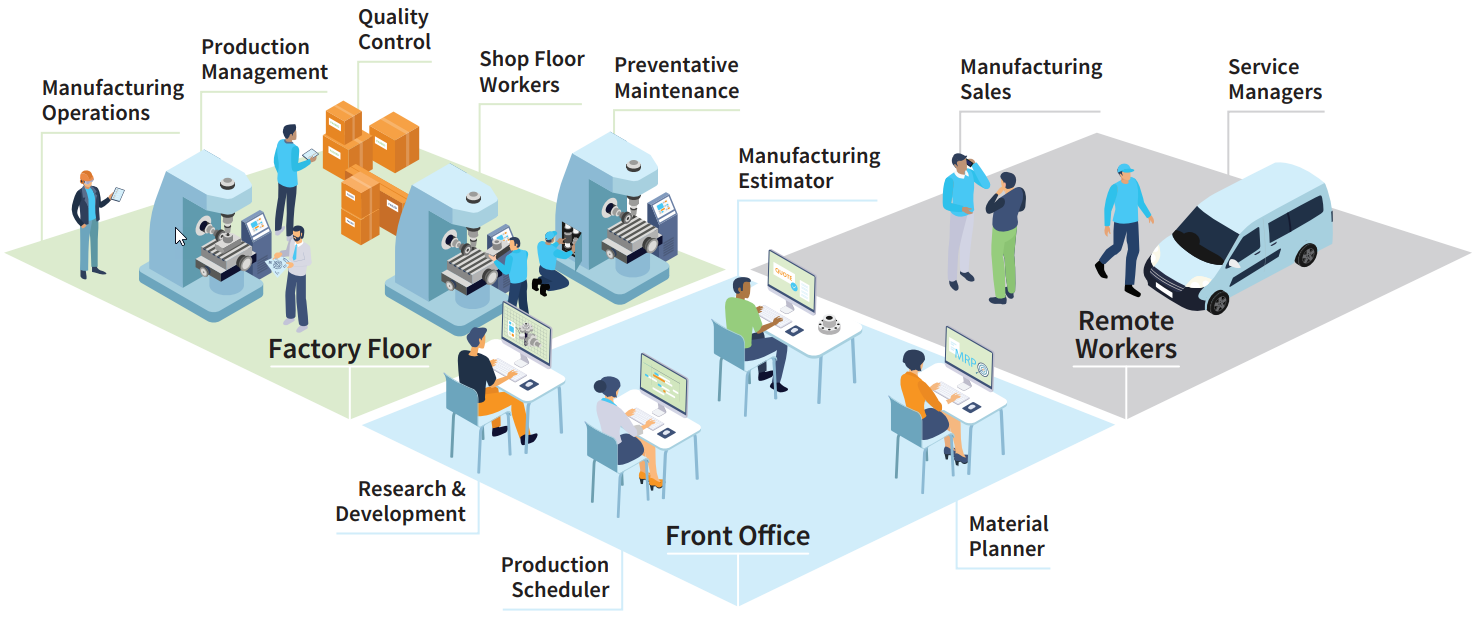Discover the Latest Manufacturing Industry Trends in ERP Implementation
Several Key Trends in the Manufacturing Industry Are Shaping How Businesses Operate Cloud-based Enterprise Resource Planning (ERP) technology can...

Drive Growth, Increase Throughput, and Streamline Operations
What are Metrics?
Business metrics are quantifiable measures used to track business processes to judge the performance level of your business. There are hundreds of these metrics because there are so many different kinds of businesses with many different processes.
Most manufacturers pay careful attention to metrics to drive daily decisions, improve quality, reduce risk, and guide operational excellence throughout their organizations. However, executives often struggle to make sense of the information due to data issues, a lack of strategic vision, missing benchmarks, and a focus on lagging indicators. Further, departmental metrics do not always align with corporate goals, and manufacturing leaders experience “paralysis by analysis” with too many metrics.
Discrete Manufacturing is all about precision and quality. Parts are made to exact dimensional specifications, precise formulations and measured against fastidious engineering standards. Managing manufacturing businesses and operational processes requires the same attention to detail to boost sales, contain costs, improve efficiency, and grow profits.
Metrics are everywhere in manufacturing organizations, from accounting to sales and quality to production. Monitoring data helps manufacturers increase sales, improve product quality, reduce costs, fend off competitors, and develop innovative products and services. For example, an Aberdeen benchmark survey shows that manufacturers reporting against KPIs for five or more years were likelier to achieve best-in-class status than those who did not actively monitor KPIs.
Why Track Metrics?
Improve Efficiency
Fend off Competitors
Align Actions with Goals
Boost Profits
Reduce Risks
Improve Decision-Making
Thrill Customers
Empower Employees
Types of Metrics
Descriptive
Descriptive analytics is commonly used for lagging indicators. This is because they help us understand what happened. However, descriptive analytics provide a foundation for other types of metrics.
Predictive
Predictive KPIs use descriptive and diagnostic metrics to identify what is likely to happen. Examples include machine breakdown forecasts or customer bankruptcy predictions that may result in excessive bad debt write-offs.
Diagnostic
Diagnostic metrics help manufacturers to understand why something happened. They are often based on descriptive analytics collected over time with formulas or artificial intelligence to spot anomalies and discover how interrelated operations or processes impact each other.
Prescriptive
Prescriptive analytics combines descriptive, diagnostic, and predictive metrics to suggest how to prevent issues from occurring before they happen. They often rely on mathematical modeling and business rules.
Measuring performance only works if you have accurate, complete, and timely data. Unfortunately, manufacturers often focus too much on lagging indicators rather than proactively monitoring leading indicators before problems erupt. Finally, too many companies focus on internal issues without comparing themselves against industry peers.
Common Mistakes
Bad Data
Lack of Strategic Alignment
Lagging vs. Leading Indicators
Missing Peer Benchmarks
Measuring the Wrong Things
There are thousands of financial, sales, manufacturing, and operational metrics that manufacturers develop and monitor to drive improvements throughout every aspect of their business. But what are the most critical metrics that transcend industry segments that everyone should consider? Below are recommendations for key performance indicators that successful manufacturers use to grow strategically.
|
FINANCIAL • Revenue • Expenses • Cash Flow |
SALES AND MARKETING • Estimates/Quotes • Marketing Leads • Customer Metrics |
|
OPERATIONS • Staffing • Operating Margin • Quote-to-Cash Cycle |
MANUFACTURING • Throughput • Schedule Attainment • Utilization and Efficiency |
Our Manufacturing Metrics That Really Matter Playbook will guide you through determining the right metrics to measure while giving you insights on metrics that may be sabotaging your efforts.
Defining metrics and key performance indicators is easy. The tricky part is collecting the data and presenting it in a meaningful way to internal stakeholders. Manual data manipulation and spreadsheet analysis delay information and result in data accuracy issues. Consequently, most manufacturers rely on specialized ERP applications and connected business intelligence to streamline data collection with automated alerts or notifications. Modern cloud ERP applications like Acumatica provide manufacturers with a foundation to combine data from multiple systems with configurable inquiries, tailored reports, actionable role-based dashboards, and dimensional data analysis to ensure data integrity and timeliness. In addition, create custom workflows to manage actions across business units and departments to facilitate organizational change.
Metrics provide manufacturing leaders with real-time business insights to remain agile and drive innovation throughout their organizations. However, manufacturers with disconnected systems and legacy ERP applications struggle to connect data across disparate platforms with few tools to streamline metric management. Modern cloud applications like Acumatica empowers manufacturing executives and departmental managers with real-time insights through role-based dashboards, live reports, and inquiries with drill-downs to source transactions. In addition, dimensional business intelligence and automated business events and workflows empower leaders with tools to manage their business objectives efficiently.
Aqurus believes in a custom approach to integrating MRP into your business. By providing better and targeted communications and AI-driven technologies to manage new customer care expectations, Acumatica’s applications can provide improved organization and efficiency to grow your business powerfully.
At Aqurus, we know how valuable Acumatica ERP software is for businesses – especially those in Manufacturing, Distribution, eCommerce, and the retail industry. If you’re interested in how Acumatica’s Cloud ERP Software can boost your business, the Aqurus team is passionate about smooth implementation and ongoing support.
The team at Aqurus can help you too. Call (403) 768-0322 or email today!

Several Key Trends in the Manufacturing Industry Are Shaping How Businesses Operate Cloud-based Enterprise Resource Planning (ERP) technology can...

How Manufacturing Automation in Canada Could Transform Your Business

Overcome the Shortage of Manufacturing Labour with Talent and the best ERP system for manufacturing. In the face of an ongoing shortage of discrete...